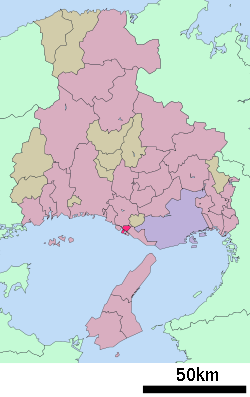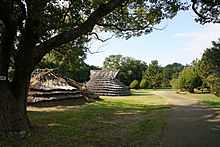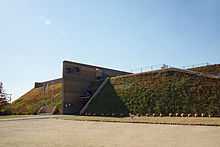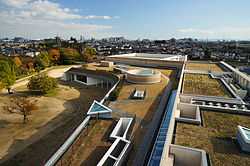Harima, Hyōgo
| Harima 播磨町 | ||
|---|---|---|
| Town | ||
|
A view from Hyogo Prefectural Museum of Archaeology | ||
| ||
 Location of Harima in Hyōgo Prefecture | ||
 Harima Location in Japan | ||
| Coordinates: 34°43′N 134°52′E / 34.717°N 134.867°ECoordinates: 34°43′N 134°52′E / 34.717°N 134.867°E | ||
| Country | Japan | |
| Region | Kansai | |
| Prefecture | Hyōgo Prefecture | |
| District | Kako | |
| Government | ||
| • Mayor | Hiroko Shimizu (since July 2006) | |
| Population (December 1, 2012) | ||
| • Total | 34,836 | |
| Time zone | Japan Standard Time (UTC+9) | |
| Symbols | ||
| - Tree | Pinus | |
| - Flower | Chrysanthemum | |
| Address |
Higashi-honjyo 1-5-30, Harima-cho(town), Kako-gun(district), Hyogo-ken(prefecture) 675-0182 | |
| Phone number | 079-435-0355 | |
| Website | Town of Harima | |
Harima (播磨町 Harima-chō) is a town located in Kako District, Hyōgo Prefecture, Japan. The town shares its name with Harima Province, one of the old provinces of Japan. Harima was known as Ae village until April 1962. The name "Harima" is derived from a large area in southwestern Hyōgo Prefecture, commonly referred to as "the country of Harima," or Banshū area.
Statistics
As of December 1, 2012, the town has an estimated population of 34,836, with 14,181 households. The total area is 9.09 square kilometres (3.51 sq mi). Approximately 30 percent of the area is a man-made island. The island is one part of the East Harima Coastal Industrial Region. It also includes a large port for international shipping. Several large companies have factories in this area. The town flower is the chrysanthemum.
Harima currently has two sister city relationships:
Harima resident charter
Harima-chō is an ancient village full of history. Our town flourishes on natural gifts and ancestral efforts. We established this charter to make our town a more peaceful and worthwhile hometown.We grow flowers and trees to make the town prosperous.
We respect one another and have opportunities to meet eye-to-eye.
We enjoy working and we create happy homes.
We are familiar with sports and we stay in shape.
We deepen our knowledge and develop a wealth of culture.
(Town charter, since March 27, 1982)
In addition a charter update was written for Harima on April 28, 1989) The following is a translation of the text.
We are living in a time of admirable history and favorable natural resources and we hope to lead a good life with a happy heart. All of us take care of each other's lives and rights. We learn together, and get in touch as comrades, and therefore widen our sympathetic circles. Now, we will get back to the basics of human respect, and we declare, "Let's live together in Harima, a town of friendly people." We aim to make a bright town where everyone lives in a happy family and greets the 21st century with pride.In Harima: We will raise consciousness about human rights and get rid of all discrimination.
We will deepen our understanding of each other and make warm human relationships.
We will make progress in learning and acquire the knowledge to live a just life.
Harima historical sites
- Onaka Ancient Village Remains (National Historical Site)
- In the Yayoi Period, the location of the Kakogawa River running through the center area of the Harima region made the area prosperous. The remains found resemble the Old Stone Culture. The Onaka Village Remains were discovered by three members of the Harima Junior High School Archaeology Club in June 1962. The remains are located on the south edge of a Pleistocene epoch plateau 13 metres (43 feet) above sea level, on the east edge of the Kakogawa river.[1]
- The remains, including a 44,000 m2 (473,612 sq ft) residential site, are characteristic of the mid-Yayoi Era to the mid-Kofun Era (A.D. 200–400) The excavation of the site also revealed a broken mirror reaffirming early trade between China and Japan. This site provides important information on the early formation of Japanese society and community structures.

- Naikōkamon Kyōhen (Mirror fragment) (Town Designated Cultural Asset)
- The mirror was excavated from the Onaka Ancient Village Remains residence site. The mirror is presumed to have been made in the late-Han Era in China. The mirror is 2.5 cm (1.0 in) in width, and would have a perfect shape of 21.2 cm (8.3 in) if fully restored. It was intentionally divided and burnished to create a flat face, with two bored holes for hanging. This is a highly valued archaeological specimen.
- The sitting statue of Yakushi-nyōrai (Town Designated Cultural Asset)
- This statue serves as one of the oldest and most precious statues of the Buddha. It is of a joined block construction 140 cm (55 in) in height, on a draping-robe style pedestal. The statue's robe is simple and the carvings are shallow to give it great elegance. Part of the statue's face, its right arm, and the medicine pot in its left hand show marks from past repairs. It is presumed to have been built at the end of the Heian Period.
- Enman-ji Temple Shaka-juryoku-zenshizō (Town Designated Cultural Asset)
- Enman-ji Temple features an image of the Buddha between two Bodhisattvas in the center of sixteen guards (gods). It is painted on a silk screen with an oath and is dated to 1395. A restoration took place in 1465. There is also a restoration of an epiphany in 1680 on the back of the silk. It has the principal image of the Buddha from three old villages, Imazato, Iwamitsu, and Futago. It is valued for its ability to show how people believed in gods in the 14th century.
- Renge-ji Temple "Raihan" (Town Designated Cultural Asset)
- The "Raihan" is a compact platform on which the chief priest of the Buddhist Temple sits to worship. An old record was left inside the platform written in Indian ink telling the history of the "Raihan." It also includes a description of Ikeda Terumasa's wife, Tokuhime's large procession to see her father, Ieyasu Tokugawa, the first shogun of the Tokugawa Era. The record provides insight into the social life in the Tokugawa period.
- Moon-watching diaries: Records for moon watching in the Edo Period (Town Designated Cultural Asset)
- These three journals handed down in the Kawabata community in the Nozoe village were kept yearly without interruption for about 150 years starting in 1720. They give general accounts of life in the community. These journals are authentic, and provide valuable historical records to study sociological aspects of the people of the time.
- Ae Shrine (Prefecture Designated Cultural Asset)
- The main shrine structure consists of two pillars at the front, running north and south, and a thatched roof. The front edges of the buildings are connected with corridor bridges. This style of architecture with for main shrine buildings linked together by bridges is rarely seen elsewhere. This unique feature lead to itself Prefectural Designated Cultural Asset status.
- Ae Shrine camphor tree in Futago (Town Designated Cultural Asset)
- This camphor tree is thought to have been planted when the Ae Futago shrine was established in 1688, and is worshiped as a holy tree to this day. This 300 year old tree is the oldest in town. It is 16 m in height and 5 m in circumference.
- Harima Elementary School camphor tree (Town Designated Cultural Asset)
- This memorial tree was planted in 1900 as one of eight camphor trees to commemorate the move of Harima Elementary School, previously named Ae Elementary School, to its present location. In order to expand the school playground, the other trees were cut down. The only remaining, more than 100 years old, tree is 12 m in height and 2.9 m in circumference.
- Hokyoin Monument (Town Designated Cultural Asset)
- This monument is made of granite and is 157 centimeters in height from its stone foundation. The erosion of the monument by time and elements have made it impossible to read the inscriptions on the stone. However, based on carving techniques it is presumed to have been built at the beginning of the Muromachi Era. It is only one of a few stone work examples found in Harima.
- Atagozuka Burial Ground (Prefecture Designated Cultural Asset)
- The only round burial ground in Harima with a moat. It was built in the mid-Kofun Era, and has been worshiped by people as "Atago-san" since ancient times. Its name comes from the shrine on top of the burial ground where Atago Bodhisattva is enshrined. The grounds are 22 by 23 metres (72 by 75 feet). The top is 15.3 m (50.2 ft) above sea level while the bottom is 13.1 m (43.0 ft) above sea level. It is 2.2 m (7 ft 2.6 in) high with a moat 4.5 m (14.8 ft) in width.
- Rishu Woodcut Sutra (Town Designated Cultural Asset)
- The Rishu Woodcut Sutra is a set of four double-sided Rishu woodcuts inscribed with the name of the year Benmei 19(1487) and the Buddhist history. The letters are engraved on each thick cherry plank. The unique, but esoteric, Buddhist text meant to lead to enlightenment is engraved in Rishu. A summary of the Muryojuin history from ancient times to 1487 was included in the history. These woodcuts are a valuable research tool in the study of Buddhist history in Japanese feudal times.
- The Shinyu Waterway—Built by Denbei Imazato
- In the years before the building of this waterway in Myōreki 1 (1655) the people suffered from an insufficient water supply. This was because only small ponds and wells provided the main source of water for rice field irrigation. There was no rain before the rice-planting season of Shōō 3 (1654). A long spell of dry weather in August resulted in no harvest or rice seed for a future crop. Denbei Imazato, then chief of the Komiya area, called the chiefs of the 23 villages together. After coming to an agreement, he helped plan the building of a flood control channel from Saijo Hiramatsu Gokanoi Sluice (now present day Kakogawa) to Okie Komiya. Denbei then presented the plan to the lord of the domain and received permission to begin construction. The project started in 1655 and was completed in March 1656. The total length of the waterway was 13 km (8 mi), and 164,000 workers were used in its construction. The improved irrigation system allowed water to reach some 6 square kilometres (2 square miles) of field area. It was developed using the Gokanoi Sluice, an ancient type of irrigation system, and it was subsequently named the Shinyu Waterway.
Folk culture
- The Shishimai of Komiya Lion Dance (Town Designated Intangible Folk Cultural Asset)
- The Lion dance is performed with two people. It is a ritual of devotion to the Komiya temple god Enoki Daimyojin from the Kan'ei era. It uses Taijin music. On September 23 of the lunar calendar ten dances are performed. Two typical examples are the 'Botan,' and 'Shiokumi' styles of dance.
Cultural facilities
- Harima Archaeological Materials Museum
- This museum exhibits archaeological materials excavated in the Onaka archaeological site. Special exhibitions, lectures, and classes are provided to visitors to experience ancient traditions and methods.

- Harima Library
- The library features a collection of about 120,000 books. The library also offers reference service, story telling gatherings, lectures on literature and handicraft classes.
Public Schools
Hyogo Prefectural Harima-Minami High School
Famous people from Harima
- Joseph Hiko—Father of the Japanese newspaper
- Joseph "Hikotaro" Hiko (1837–1897), Joseph Heco, was born in Komiya, Harima. He was rescued at the age of 13, in 1850 from a shipwreck on Eiriki-maru. He was then taken to America by an American merchant. He was the first Japanese person to be naturalized as an American citizen in 1858. He was baptized as a Christian and chose the name 'Joseph Hiko.' He was instrumental as a translator in forming the "Treaty of Friendship" between Japan and the United States. He also helped send delegations from the Tokugawa shogunate to the USA.
- In addition, he published the first Japanese newspaper, Kaigai Shinbun, in 1864. It contained news of the world and a short overview of American history. Hiko's nickname 'The Father of the Japanese Newspaper' is a result of this achievement.
- Hiko met U.S. President Lincoln in 1861, and came to know democracy at that time. He also met President Franklin Pierce. He had a long and successful career as a statesman, commercial agent, and translator. He visited Harima three times, and set up a tombstone for his parents. This tombstone is located at Rengeji Temple in Honjo. It is now commonly referred to as "The Tombstone with European letters."
- Hiko had a mixed relationship with his home country of Japan. Many Japanese people were not happy with the new outside foreign influences of the world coming into Japan. He was buried in Aoyama, Tokyo in the foreign section of the cemetery, as he was an American citizen. However, he has become quite a celebrated figure in Harima in recent years.
- Masaki Sumitani (H.G.) — Japanese Comedian, Actor, and Talent
- Masaki Sumitani was born December 18, 1975 in Harima. He was a student at Harima Junior High School, and later attended Kakogawa Higashi Senior High school. His stage name is Razor Ramon HG, but is more commonly known as H.G. (Hard Gay). He appears on a variety of Japanese television shows.
Harima International Friendship Association
The Harima International Friendship Association (HIFA) maintains sister-city relationships with Lima, Ohio in the USA and Heping, Tianjin in China. Activities include yearly cultural exchanges between the people of Harima and their sister-city partners.
References
- ↑ Harima, a Place of History and Culture
External links
![]() Media related to Harima, Hyōgo at Wikimedia Commons
Media related to Harima, Hyōgo at Wikimedia Commons
- Harima official website (Japanese)
